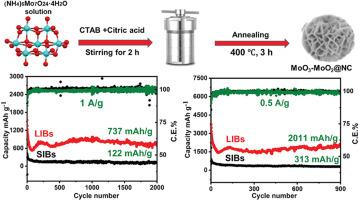制备双相MoO3-MoO2@N-doped纳米碳球实现Li/Na存储的快速离子传输
IF 7.9
2区 工程技术
Q1 CHEMISTRY, PHYSICAL
引用次数: 0
摘要
开发具有高容量和长期稳定性的高性价比负极材料对于推进锂离子电池和钠离子电池的发展至关重要。在这项工作中,我们介绍了一种双相三氧化钼-二氧化钼氮掺杂碳纳米复合材料(MoO3-MoO2@NC),通过一步水热法和400℃煅烧合成。这种异质结构结合了MoO3的高理论容量与MoO2优越的导电性和结构耐久性,而NC则增强了电子传递和机械稳定性。MoO3-MoO2界面促进了快速的氧化还原动力学和离子扩散,从而导致了优异的电化学性能。该复合材料在锂离子电池中经过700次循环后,在500 mA g−1下达到1652.1 mAh g−1,在1000 mA g−1下保持737.5 mAh g−1,超过了传统的钼基阳极。在sib中,它在500 mA g - 1下循环900次后保持313 mAh g - 1,表现出优异的稳定性。在全单元(lib / sib)配置中,它提供了良好的稳定性,证明了其在现实世界中的适用性。双相工程、伪电容电荷存储和定制纳米结构的集成使MoO3-MoO2@NC成为下一代储能系统的有前途的阳极。本文章由计算机程序翻译,如有差异,请以英文原文为准。

Fabrication of dual-phase MoO3-MoO2@N-doped carbon nanopetal spheres to achieve quick ion transport for Li/Na storage
The development of cost-effective anode materials with high capacity and long-term stability is crucial for advancing lithium-ion (LIBs) and sodium-ion batteries (SIBs). In this work, we introduce a dual-phase molybdenum trioxide–molybdenum dioxide nitrogen-doped carbon (MoO3-MoO2@NC) nanopetal composite, synthesized via a one-step hydrothermal process and calcination at 400 °C. This heterostructure combines the high theoretical capacity of MoO3 with the superior conductivity and structural durability of MoO2, while NC enhances electron transport and mechanical stability. The MoO3-MoO2 interface promotes fast redox kinetics and ion diffusion, leading to exceptional electrochemical performance. The composite achieves 1652.1 mAh g−1 at 500 mA g−1 after 700 cycles in LIBs and retains 737.5 mAh g−1 at 1000 mA g−1 over 2000 cycles, surpassing conventional Mo-based anodes. In SIBs, it maintains 313 mAh g−1 after 900 cycles at 500 mA g−1, demonstrating excellent stability. In full-cell (LIBs/SIBs) configurations, it delivers good stability, proving its real-world applicability. The integration of dual-phase engineering, pseudocapacitive charge storage, and tailored nanostructure establishes MoO3-MoO2@NC as a promising anode for next-generation energy storage systems.
求助全文
通过发布文献求助,成功后即可免费获取论文全文。
去求助
来源期刊

Journal of Power Sources
工程技术-电化学
CiteScore
16.40
自引率
6.50%
发文量
1249
审稿时长
36 days
期刊介绍:
The Journal of Power Sources is a publication catering to researchers and technologists interested in various aspects of the science, technology, and applications of electrochemical power sources. It covers original research and reviews on primary and secondary batteries, fuel cells, supercapacitors, and photo-electrochemical cells.
Topics considered include the research, development and applications of nanomaterials and novel componentry for these devices. Examples of applications of these electrochemical power sources include:
• Portable electronics
• Electric and Hybrid Electric Vehicles
• Uninterruptible Power Supply (UPS) systems
• Storage of renewable energy
• Satellites and deep space probes
• Boats and ships, drones and aircrafts
• Wearable energy storage systems
 求助内容:
求助内容: 应助结果提醒方式:
应助结果提醒方式:


